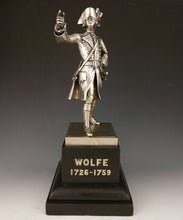Major-General James Wolfe (1759-75), 1910
Adding product to your cart
Height overall: 37cm (14.5in)
Silvered bronze figure of Major General James Wolfe, Commander in Chief of his Majesty’s Forces in the Expedition against Quebec, mounted on an ebonised wood base. Modelled after the painting J.S.C. Schaak. Maker’s signature of Goldsmiths & Silversmiths Company Ltd, 112 Regent St., London W. Height of figure excluding base 25cm (10in).
Read more
Schaak’s portrait of Wolfe, now in National Army Museum and from which the present model is derived, was based on a drawing by Wolfe’s Aide-de-Camp Captain Henry Smith (1734-1811) who fought alongside Wolfe during the Gulf of St. Lawrence Campaign in 1758 and is pictured holding Wolfe’s right arm in the Benjamin West’s famous painting ‘The Death of General Wolfe’. Schaak’s portrait of Wolfe is one of three portraits can properly claim to represent a true likeness. In the decades Following General Wolfe's death on the Plains of Abraham in 1759, Schaak’s full length portrait became the best known image of Britains’s greatest hero until Nelson.
The figure shows Wolfe with outstretched arm pointing the way to the cliff path to the Plains of Abraham on the fateful date of 13 September 1759. He is shown wearing uniform coat, tricorne hat but without the black crepe band, depicted by Schaak, worn on his left arm in mourning for his father, Lieutenant-General Edward Wolfe, who died in March 1759. Wolfe reached Halifax on 30 April 1759 with a smaller force than had been promised in London.
Wolfe’s plan was to attack his French opponent, the Marquis de Montcalm, from St Michel, three miles above Quebec, whilst his brigadiers carried out diversionary assaults. This, however, was abandoned and in the early hours of 13 September, having personally reconnoitred the scene, Wolfe landed his troops only two miles above Quebec and by dawn had established his army on the Plains of Abraham. Wolfe was fatally wounded at the outset of the battle though he lived to hear of its success. Quebec fell five days later leading to Britain’s annexation of Canada.








